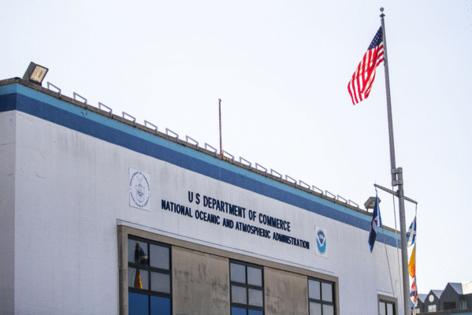Federal cuts to NOAA could be an 'incredible blow' for Chesapeake Bay, storm reporting
Published in News & Features
NEWPORT NEWS, Va. — As summer and hurricane season nears, weather and environmental officials say federal cuts to the National Oceanic and Atmospheric Administration will negatively impact climate research, education and storm reporting.
The Trump administration reportedly plans to cut NOAA’s roughly $6.1 billion budget by 27% to $4.5 billion in fiscal year 2026. According to an internal administration document obtained by ProPublica, the proposed cuts would close the Cooperative Institute for Marine and Atmospheric Sciences and the Atlantic Oceanographic and Meteorological Laboratory, which could end support for NOAA’s hurricane hunter missions, and cut funding to the office of Oceanic and Atmospheric Research by nearly 75%.
Environmentalists on the Chesapeake Bay are worried about how cuts could affect its ecosystem and restoration. The budget for the National Marine Fisheries Service, the agency that manages fisheries and marine ecosystems under NOAA, would be cut roughly 30%, from $1.1 billion to $789.3 million in fiscal 2026, according to the Chesapeake Bay Foundation.
The plan also would move the National Marine Fisheries Service and its Chesapeake Bay Office under the Department of the Interior’s Fish and Wildlife Service.
Alison Prost, senior vice president for programs at the Chesapeake Bay Foundation, said the move would be an “incredible blow” to its ecosystem and restoration in Virginia. Last year, the overall health of the Chesapeake Bay, the nation’s largest estuary, received its highest grade since 2002, but bay researchers say more work needs to be done.
“NOAA’s science is critical for restoring oyster reefs, managing commercially important fisheries like blue crabs and protecting our region’s homes and businesses from climate change,” Prost said. “This attack on NOAA jeopardizes what we know works best for restoration — world-class science, innovation and a strong partnership between the states and federal government.”
As of Friday, NOAA officials have not commented publicly about the planned cuts. The proposed changes come at a time where programs and department budgets across the federal government have been slashed, which federal officials have said saves money and makes the government more efficient.
Cuts are also coming to NOAA’s Office of Education. In the 2014 Chesapeake Bay Watershed Agreement, signed by governors of all states in the Chesapeake Bay watershed, public and private school students are required to participate in “meaningful watershed educational experiences” at least once during each level of instruction — in elementary, middle and high school.
Many of these experiences are funded through NOAA’s Chesapeake Bay Watershed Education and Training grant program, which awards $50,000 to $150,000 to each grantee annually for up to three years for K-12 learning opportunities. Awards in the past have gone to local governments, universities, school systems and nonprofits.
“NOAA has helped connect countless students with the world around them, from paddling a canoe to walking through the marsh or using state-of-the-art scientific tools to measure local water quality,” said Tom Ackerman, the foundation’s vice president for education. “These programs help prepare students to solve the complex problems of tomorrow.”
The cuts could also negatively affect forecasters’ ability to issue alerts and warnings for severe storms, cautioned the American Meteorological Society. With the upcoming cuts, the National Weather Service’s models and products will stagnate, observational data collection will be reduced and public outreach will decrease, the society said. Basically, the “scientific backbone” and workforce needed to keep weather forecasts, alerts, and warnings accurate and effective will be drastically undercut, the AMS added.
Although effects are unknown, the AMS said it is “almost certainly disastrous” for public safety and economic health. The society points to the national Doppler radar network and the NOAA Hurricane Hunter aircrafts as success stories from years of the administration’s research.
“Imagine what will happen to tornado and severe thunderstorm warnings if we don’t have a robust national weather radar network,” an AMS statement said. “What will happen to reservoir management when critical information on rainfall and runoff goes missing? What will happen when Hurricane Hunter aircraft are delayed or data from their instruments are not available to improve hurricane track and landfall forecasts? NOAA research affects the lives of American taxpayers every day.”
Last year, severe weather cost Virginia more than $500 million. With climate change making weather disasters more frequent and severe, the meteorological society said NOAA research is becoming more important.
More accurate forecasting saves money. Research from the National Bureau of Economic Research found that greater accuracy of hurricane forecasts in 2020 relative to 2007 saved about $5 billion in emergency funds and damages. The AMS released its own research last year on savings, which found NOAA’s weather forecasts generate more than $73 in savings for every dollar invested.
In addition to forecasting cuts, NOAA data are on the chopping block. The administration announced that several datasets are slated for “retirement,” including the coastal water temperature guide and the marine environmental buoy database. Others are being consolidated or renamed, and while some datasets will continue to exist on NOAA’s websites, the administration will no longer support the maps created from that data.
©2025 The Virginian-Pilot. Visit pilotonline.com. Distributed by Tribune Content Agency, LLC.







Comments